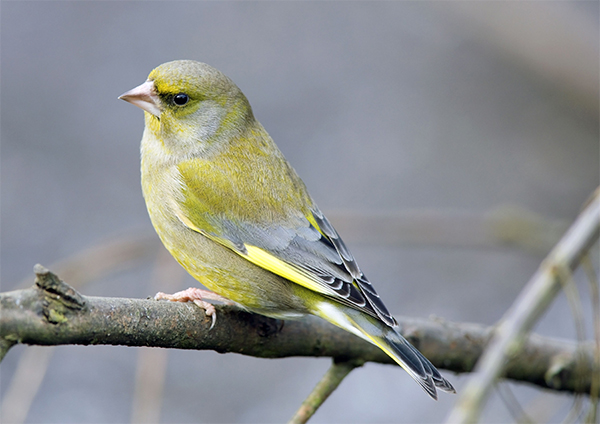May bird of the month – Greenfinch
Scientific name: Carduelis chloris
The aptly named Greenfinch is our bird for May, you may have also hear it called the Green Linnet and Green Grosbeak depending on the locale. Once a favourite of the Victorians to trap and cage with clap nets to keep as pets but the Greenfinch was not nearly as prized as Goldfinches or Linnets.
Geenfinches live to approximately 2 years.

Identification:
- Feather colour – Male Greenfinches are a dull olive-green with greenish-yellow on the breast which appears bright green in the sunlight. Adult females on the other hand are duller in appearance, with less visible yellow plumage. Southern-European Greenfinches tend to be brighter than Northern-European birds.
- Leg colour – they have a brown to pink leg colouring.
- Beak – their beaks are black-brown, short and thick.
Young Greenfinches can be difficult to identify as they lack the distinctive yellow plumage on their tail and primaries which is present in the adults.
Measurements:
Greenfinches typically grow to an approximate length of 15cm, with a wingspan of 26cm and weigh 28g.
Vocalisations:
Greenfinches can be recognised by their ‘chichichichichit’ continual vocals as they fly, as well as their characteristic nasal “dzwee”, particularly during the breeding season.
The cock has a distinctive and continuous flight song, flying with slow deep wing beats.
Breeding:
Breeding season usually begins in early April with their first clutches complete by the end of the month. Clutch sizes can vary from 4 – 6 eggs, with an incubation stage of about 11- 15 days and fledgling taking place 14-18 days after.
Generally a breeding pair will try for two broods a year.
Nesting:
Greenfinches can be found throughout gardens, parks woodland and farmland, usually nesting in small colonies in trees and bushes. The only areas you won’t find Greenfinches is in upland areas without trees and bushes.
Abundance:
A common bird throughout Europe and as of the 1950’s they’re typically found in towns, villages, parks and gardens. Greenfinches are known to breed from the Mediterranean to the artic, the only area they’re not present is in Iceland.
Since these birds were introduced to other countries such as south-east Australia, Tasmania, New Zealand, Uruguay and Argentina, they’ve become well-established. In south-east Asia you can find four close relatives to the Greenfinch, these being the Oriental, Himalayan, Vietnamese and Black-headed.
It’s been recorded through ringing that Greenfinches will move up to 2000km but British breeding birds typically only move up to 20km from their birthplace.
In winter the number of Greenfinches in Britain increases as the Scandinavian birds head over.
Greenfinch numbers are beginning to suffer due to an outbreak of trichomonosis, their numbers did pick up after a decline during the late 1970’s and early 1980’s.
The UK sees approx. 1,700,00 breeding pairs.
What they eat:
Greenfinches are a common visitor to bird tables, particularly enjoying sunflower. Due to their large bill the Greenfinch can enjoy a more varied diet, including larger seeds and peanuts.
They can often be found in social groups feeding at the bird table and in the autumn time it’s not unheard of to see flocks of hundreds of birds. They are even happy to feed around other ground-foraging bird species at the tables such as tree sparrows, linnets, yellowhammers and reed buntings.
Bird safety:
The approximate 20% decline at the moment is mainly due to the outbreak of trichomonosis, a disease caused by the protozoan parasite Trichomonas gallinae. The disease is fatal, as a result of the birds’ difficulty swallowing food. It’s spread by birds sharing dirty feeders or drinking water, therefore we suggest a strict cleaning routine for all bird care products and the areas around them.
Looking for further advice?
Then why not pop into your local Scotsdales store today and speak with a member of our knowledgeable team. We will be happy to assist in any way we can with advice and guidance regarding the best options for birds in your garden.




